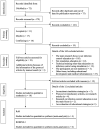Simulation-based infection prevention and control training for medical and healthcare students: a systematic review
- PMID: 40438369
- PMCID: PMC12116496
- DOI: 10.3389/fmed.2025.1529557
Simulation-based infection prevention and control training for medical and healthcare students: a systematic review
Abstract
Introduction: Infection prevention and control education has traditionally been conducted in a lecture-based manner, and simulation-based educational strategies have become increasingly prevalent in the field of medical education in recent years. This systematic review aimed to compare the effectiveness of the simulation-based and traditional strategies of infection prevention and control education and to show the differences between these educational approaches. Furthermore, we identified the characteristics of simulation-based strategies for infection prevention and control education.
Method: Systematic reviews and meta-analyses were performed according to the Preferred Reporting Items for Systematic Reviews and Meta-Analyses guidelines. A systematic literature search was conducted using the CENTRAL, MEDLINE, and Scopus databases for articles published between January 1990 and September 2022. This study focused on students enrolled in medical and health professional courses. As such, healthcare professionals already working in clinical settings, as well as kindergarten and elementary school students were excluded from the study. The quality of the included studies and the risk of bias in each study were assessed. A total of 254 articles were identified; 21 underwent secondary screening. Ultimately, 10 articles were selected for the final review.
Results: Educational strategies between simulation- and lecture-based education showed improvements in knowledge acquisition. There was no significant difference in the rate of improvement between the two educational strategies. The characteristics of simulation-based educational strategies included confidence in skill performance, decision-making and problem-solving skills, emotional aspects related to infectious diseases (such as fear, empathy, self-reflection, and integration of complex information), and student satisfaction.
Conclusion: This systematic review suggests that simulation-based education is effective in developing students' skills and attitudes, while traditional lecture-based methods are more suited for reinforcing students' knowledge. Therefore, it is essential to choose educational strategies based on specific learning objectives and outcomes.
Systematic review registration: This systematic review protocol was preregistered in the Open Science Framework: https://osf.io/uj623/.
Keywords: infection control; infection education; infection prevention; simulation education; students; systematic review.
Copyright © 2025 Yoshikawa, Ohtsuka, Aoki, Tashiro, Togo, Komaba, Nogawa, Osawa and Enokida.
Conflict of interest statement
The authors declare that the research was conducted in the absence of any commercial or financial relationships that could be construed as a potential conflict of interest.
Figures
Similar articles
-
Student and educator experiences of maternal-child simulation-based learning: a systematic review of qualitative evidence protocol.JBI Database System Rev Implement Rep. 2015 Jan;13(1):14-26. doi: 10.11124/jbisrir-2015-1694. JBI Database System Rev Implement Rep. 2015. PMID: 26447004
-
The effectiveness of internet-based e-learning on clinician behavior and patient outcomes: a systematic review protocol.JBI Database System Rev Implement Rep. 2015 Jan;13(1):52-64. doi: 10.11124/jbisrir-2015-1919. JBI Database System Rev Implement Rep. 2015. PMID: 26447007
-
Recovery schools for improving behavioral and academic outcomes among students in recovery from substance use disorders: a systematic review.Campbell Syst Rev. 2018 Oct 4;14(1):1-86. doi: 10.4073/csr.2018.9. eCollection 2018. Campbell Syst Rev. 2018. PMID: 37131375 Free PMC article.
-
Folic acid supplementation and malaria susceptibility and severity among people taking antifolate antimalarial drugs in endemic areas.Cochrane Database Syst Rev. 2022 Feb 1;2(2022):CD014217. doi: 10.1002/14651858.CD014217. Cochrane Database Syst Rev. 2022. PMID: 36321557 Free PMC article.
-
Protocol for educational programs on infection prevention/control for medical and healthcare student: A systematic review and meta-analysis.PLoS One. 2022 Oct 27;17(10):e0276851. doi: 10.1371/journal.pone.0276851. eCollection 2022. PLoS One. 2022. PMID: 36301969 Free PMC article.
References
-
- Headquarters W. (2021). The impact of COVID-19 on health and care workers: a closer look at deaths. World Health Organization. Available online at: https://iris.who.int/handle/10665/345300 (Accessed 1/11/2024).
-
- Zingg W, Holmes A, Dettenkofer M, Goetting T, Secci F, Clack L, et al. . Hospital organisation, management, and structure for prevention of health-care-associated infection: a systematic review and expert consensus. Lancet Infect Dis. (2015) 15:212–24. doi: 10.1016/S1473-3099(14)70854-0, PMID: - DOI - PubMed
Publication types
LinkOut - more resources
Full Text Sources
Research Materials




